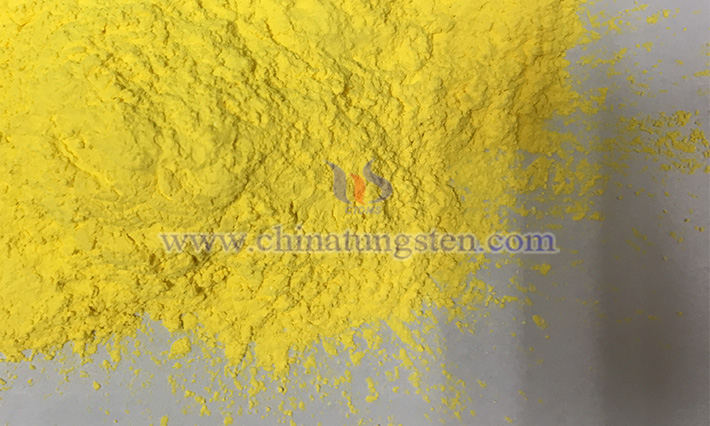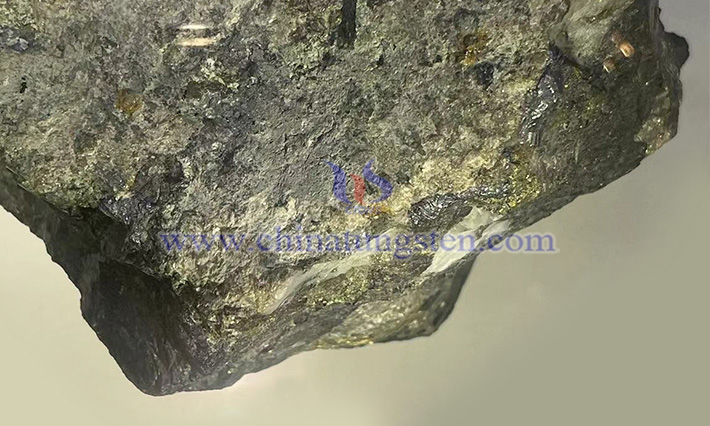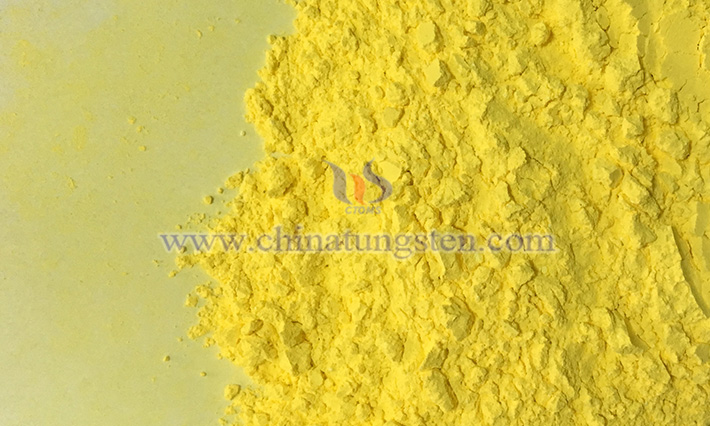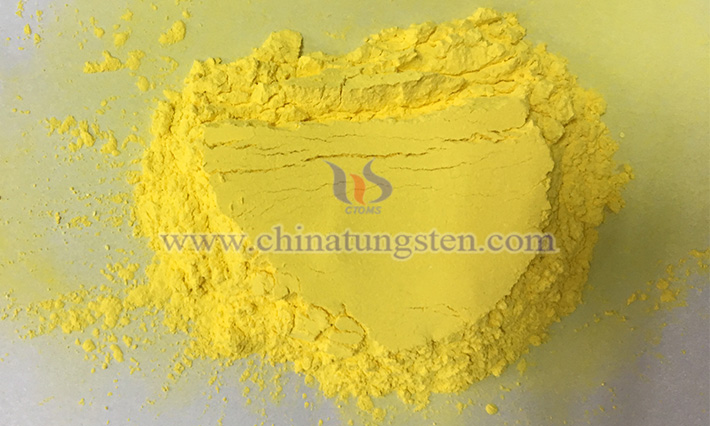What Factors Affect Yellow Tungsten Oxide Properties?
- Details
- Category: Tungsten Information
- Published on Sunday, 30 March 2025 15:27
Yellow tungsten oxide (WO₃), produced by CTIA GROUP LTD, is a crucial oxide of tungsten. Visually, it appears as a fine, yellow crystalline powder. At room temperature, WO₃ exhibits stable properties, making it relatively safe for storage and transportation without requiring special environmental conditions to maintain its chemical structure. With a density of approximately 7.16 g/cm³, a melting point as high as 1473°C, and a boiling point exceeding 1750°C, its ability to remain solid under high temperatures lays the foundation for its applications in high-temperature industrial settings. Additionally, WO₃ is insoluble in water and inorganic acids (except hydrofluoric acid) but dissolves in alkaline solutions such as ammonia. This unique solubility determines its reactivity and application potential in various chemical environments.

I. Preparation Conditions: The Key to Unlocking Yellow Tungsten Oxide Properties
The preparation conditions of yellow tungsten oxide from CTIA GROUP LTD are pivotal in determining its properties, much like a meticulously crafted recipe where different parameters impart WO₃ with a distinct "personality."
1. Temperature and Rate: The Sculptors of Yellow Tungsten Oxide Properties
In the preparation process, temperature and reaction rate act like invisible hands, skillfully shaping WO₃’s characteristics. At lower preparation temperatures, the resulting WO₃ is more reactive, akin to a lively young inpidual with high chemical activity. This WO₃ demonstrates better solubility in water, interacting with it more readily. Conversely, as the preparation temperature increases, WO₃ seems to "mature" over time, developing a denser and more stable crystal structure. The WO₃ produced at higher temperatures is chemically less reactive and nearly insoluble in water, displaying markedly different solubility traits.
2. Different Preparation Methods: perse Pathways to Yellow Tungsten Oxide Properties
The preparation of yellow tungsten oxide can follow various methods, each akin to a unique path leading to a castle of properties, ultimately endowing WO₃ with distinct characteristics.
Solid-State Reduction Method: A commonly used approach, this method begins with crushing selected tungsten ore, mixing it thoroughly with a reducing agent (e.g., carbon), and transferring it to a continuous furnace. Under high temperatures, a series of chemical reactions occur, leaving behind a fluffy metallic residue. This is then crushed, separated from non-metallic materials, and screened to yield WO₃ powder. Due to the lack of refining, the purity of the resulting yellow tungsten oxide heavily depends on the raw material quality. The powder exhibits irregular, fluffy particles with a soft texture and good pre-sintering strength, making it advantageous in fields like powder metallurgy where material formability is critical.

Electrolytic Method: By selecting appropriate conditions—such as electrolyte composition, concentration, temperature, and current density—many metals can be precipitated in fluffy or powdered forms. For WO₃, electrolysis is also viable. Post-electrolysis processing, including washing, drying, reduction, annealing, and crushing, is often necessary. This method produces high-purity, high-density WO₃ powder due to precise control over reaction conditions, making it ideal for high-purity applications like electronics manufacturing and optical materials.
Chemical Method: Common chemical powder processing involves redox reactions, precipitation, or thermal decomposition from solutions. When preparing WO₃ chemically, the resulting powder’s properties vary widely, though particle size and shape remain relatively consistent. For instance, redox powders often appear "sponge-like" with numerous pores, offering a large specific surface area and potential in catalysis. Precipitation powders from solutions have narrow particle size distributions and high purity, suitable for high-demand applications like premium pigment production. Thermal decomposition, often used for metal carbonyls, yields powders with purity exceeding 99.5% after grinding and annealing, serving critical research and industrial applications requiring exceptional purity.
II. The Fascinating Link Between Particle Size and Color of Yellow Tungsten Oxide
The particle size of yellow tungsten oxide acts like a magical color wizard, enabling WO₃ to display varying hues. When the crystal size of CTIA GROUP LTD yellow tungsten oxide is around 1.5 μm, it resembles blooming rapeseed flowers in spring, showcasing a vibrant yellow. However, when the size increases to about 15 μm, it transforms into a lush green, reminiscent of summer foliage. This color shift stems from the interaction between light and matter. Smaller WO₃ particles scatter and absorb light differently than larger ones—small particles scatter shorter wavelengths more effectively, enhancing the perception of yellow light, while larger particles alter light transmission and reflection paths, resulting in green hues. This is analogous to how fine dust appears white or pale yellow in sunlight, while larger sand grains reveal their inherent color.

III. The Impact of Impurity Elements on Yellow Tungsten Oxide Properties
On the "stage" of yellow tungsten oxide properties, impurity elements may seem like minor players, yet they exert a significant influence.
Iron, Copper, Nickel, Cobalt, etc.: These act as "promoters" in WO₃ crystal growth. When present, they actively participate in the growth process of WO₃-x crystals, encouraging larger crystal sizes and increasing particle dimensions. For example, experiments show that trace iron in yellow tungsten oxide significantly enlarges crystal size by providing additional growth sites, accelerating crystal development—much like adding more workers to a construction site speeds up building progress.
Manganese, Chromium, Zinc, etc.: These elements serve as "inhibitors," disrupting normal WO₃ crystal growth and reducing WO₃-x particle size. Take manganese: when present, it competes with tungsten atoms for growth space, impeding further crystal expansion and resulting in smaller WO₃ particles—akin to roadblocks slowing down traffic.
These impurities affect more than just particle size; they also influence other properties. For instance, copper doping may alter WO₃’s electronic structure, impacting conductivity, while optically active impurities could shift its color or modify its light absorption and emission characteristics.

IV. Temperature Environment: A Dynamic Influencer of Yellow Tungsten Oxide Properties
Temperature acts like a magical maestro for CTIA GROUP LTD yellow tungsten oxide, orchestrating fascinating changes in its properties at different levels.
WO₃’s crystal structure undergoes distinct transformations with temperature, akin to a "metamorphosis saga." At -50°C to 17°C, it adopts a triclinic system, with atoms arranged like neatly stacked blocks. Between 17°C and 330°C, it shifts to a monoclinic system, rearranging atomic patterns as if the blocks were reassembled. From 330°C to 740°C, it becomes orthorhombic, with yet another atomic adjustment. Above 740°C, it transitions to a tetragonal system, adopting a new arrangement.
These structural shifts significantly affect WO₃’s catalytic, optical, and electrical properties:
Catalysis: Different crystal systems alter surface atom arrangements and active site distributions, impacting catalytic activity and selectivity. Monoclinic WO₃ may excel in organic synthesis reactions, while orthorhombic WO₃ could enhance hydrogen production in water-splitting reactions.
Optics: Structural changes modify WO₃’s band structure and electron transitions, altering light absorption and emission profiles.
Electronics: Variations in structure influence electron transport and conductivity, with tetragonal WO₃ potentially offering superior conductivity for electronic applications.

V. Other Factors Influencing Yellow Tungsten Oxide Properties
Beyond the key factors above, environmental conditions like light and humidity also affect WO₃. Under illumination, photochemical reactions may alter its optical and electrical properties, with prolonged exposure causing slight color changes due to electron transitions. In humid environments, WO₃ may adsorb water—though insoluble, surface moisture can impact its electrical and chemical reactivity, potentially reducing insulation performance in electronic applications.
- Chinatungsten Online: www.tungsten-oxide.com
- CTIA GROUP LTD: en.ctia.group
- Tungsten News & Price: www.ctia.com.cn
- Molybdenum News & Price: news.molybdenum.com.cn
- Tel.: 86 592 5129696; Email: sales@chinatungsten.com



 sales@chinatungsten.com
sales@chinatungsten.com